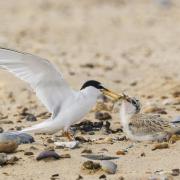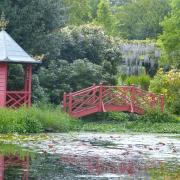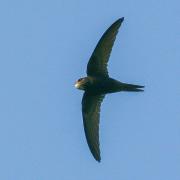Five species of deer roam the Suffolk countryside, ranging in size from the diminutive Reeves’ muntjac to our largest native land mammal, the Red deer. Only the Red and Roe are native, although the Fallow deer is a long-established member of the county’s fauna.
It is believed that Fallow deer were brought to these shores from the Mediterranean for hunting, probably by the Normans in the 11th century. They are typically identified by their beautiful coat, a russet background speckled with white, although the colour can vary from almost black to near white and the characteristic markings may even be absent.
Resident in woodland and copses, but regularly spotted in fields and on heathland, these deer are a common sight, notable hotspots being Sutton and Hollesley Common, and Rendlesham Forest. In autumn mature males or bucks sport huge, palmate antlers in preparation for the rutting season. Deer antlers are composed of bone and cartilage; they are grown annually, by males only in Suffolk’s species.


Fallow females (does) give birth in May or June, usually to a single fawn, which is hidden in the undergrowth for the first week or more of its life, relying on its spotted coat for camouflage. The mother visits every few hours to nurse her offspring. Eventually the fawn takes its first hesitant steps on long, unsteady legs, often a comical sight, as if the infant is auditioning for the lead role in Bambi.
Roe bucks have more modest antlers than their Fallow relatives, typically with just three points. This is a medium sized species with grey-brown fur in winter, moulting to reveal a slick rusty red summer coat, with a white or buff powder-puff rump year-round. With large, oversized ears and prominent black eyes and noses, Roe are arguably our most attractive deer. Widespread throughout the county, they are crepuscular by nature and most active at dawn and dusk.

Their diet includes a wide range of vegetation including brambles, heather, leaves, grass, and even fungi and acorns. Females give birth to two, occasionally three, white-spotted kids in May or June. The infants can run when just a few days old but, like fallow deer young, are left hidden and unattended for long periods. They remain with their mother until the following summer.
The muntjac’s loud, staccato call is now a familiar sound throughout our county, reflecting its alternative name of Barking deer. It was introduced to England from China and, having found the Suffolk countryside much to its liking, this deer’s population has boomed in recent years to the point where they seem ubiquitous, even taking up residence in gardens.

Their presence is divisive; some people are thrilled to see these herbivores, but among gardeners, farmers and even conservationists they may be considered a nuisance due to their potentially damaging browsing. The male’s antlers may be short – rarely more than 10cm – but they can inflict damaging facial injuries on their rivals. These small, stocky deer are unusual for having no set breeding season; fawns are born at all times of the year.
Another invasive species, the Chinese water deer is native to China and Korea and lives in wetlands. The clue is in the name; but what makes this animal unique among our deer is the lack of antlers in the male. Fang-like, elongated upper canines give the species its alternative name of Vampire deer. Both sexes have these protruding teeth but they're much less developed in the females. A male's canines can grow up to 7cm in length and are used during territorial disputes. Fighting bucks often inflict serious injuries on one another and it's not uncommon to see individuals with torn ears and blinded eyes as a result of these battles.

With more specific habitat requirements than the muntjac, this slightly larger deer hasn’t spread as widely as its Asian relative, but it's still made significant inroads, particularly around the wetlands on the Suffolk/Norfolk border. Since the first escapees in Bedfordshire survived and bred in the late 19th century, they have gradually increased to establish a population of between 1,000 and 2,000 in southern England, with East Anglia being their stronghold. Ironically, in its native East Asia the species has declined to such an extent that it is officially classified as vulnerable by the International Union for the Conservation of Nature. If current trends continue, it is likely that Britain will host a significant percentage of the total world population.
Red deer are most renowned for their majestic mature stags, weighing in at up to 200kg, and their autumn battles for the right to mate with the local females. Rutting usually starts in late September, peaking in October, and is an unforgettable spectacle. RSPB Minsmere and Westleton Heath are among the best locations in Suffolk to see these animals. Some of Britain’s biggest stags live here; the resident males are typically larger than their Scottish highland counterparts, the famous Monarchs of the Glen.

During the mating season, dominant males head off to traditional rutting areas where they aim to contain a harem of up to 15 females (hinds), and sire the next generation. The stags can often be seen thrashing their antlers among the vegetation to intimidate rivals, and rearing up on their back legs to rub their armoury against low lying branches, keeping themselves in pristine condition for the battles ahead.
Suffolk’s deer populations are generally thriving, and a sixth species, the Sika, will surely be joining them soon having already been recorded in Norfolk, Cambridgeshire and Essex. But large numbers of deer inevitably bring some conflicts with people. Raiding of crops, plantations and gardens often has financial and emotional consequences, and collisions between motor vehicles and deer can result in significant damage and serious injuries to both parties.
In the absence of natural predators – wolves and lynx have long since gone extinct in Britain – the numbers of these diverse and fascinating animals unfortunately need to be restrained via controlled culling.

What's love got to do with it?
Picture a Suffolk heath at dawn on a chilly autumn morning. As the darkness retreats it reveals slivers of mist hugging the landscape like carelessly discarded carnival ribbons caught up on the bracken and gorse. In the distance it’s just possible to make out the shapes of a herd of grazing Red deer, partly shrouded by the transparent cloak.
Suddenly the tranquillity of this enchanting rural scene is interrupted as a huge, muscular Red deer stag enters the stage, adorned by a pair of massive, branched antlers. He throws his head back and bellows out a roar across the heathland, his warm breath forming a temporary cloud in the cold air. He has thrown down the gauntlet, making it clear to any potential competitors that he alone is monarch of this patch.

Less than a minute later out of the mist comes an answering bellow, the challenge has been accepted by a younger, testosterone-charged stag. The two fearsome beasts theatrically parade alongside each other for a close-up view of their opponent's body bulk and fearsome weapons. Neither animal backs down, so they briefly part and then, antlers lowered, they charge headlong into one another, the sound of clashing bone reverberating across the heath.
Heads at ground level, locked together by their entwined antlers they push and shove, backwards and forwards, attempting to stab their opponent. Detritus flies through the air as tines and hooves plough up the soft terrain. Soon the challenger is losing ground; as he wheels around, in a desperate attempt to turn the tide, he reveals deep, crimson wounds to his neck and flank. He is tiring and at risk of serious injury or even death. He wisely breaks from the clinch, turns tail and flees through the bracken. The victor briefly purses his rival, roaring triumphantly; but rapidly returns to his harem. He still reigns supreme in this corner of Suffolk.



























